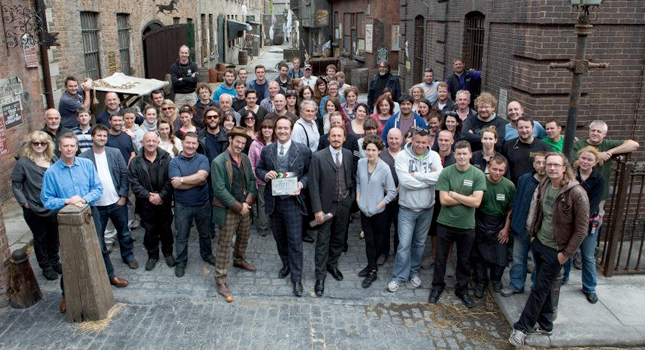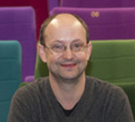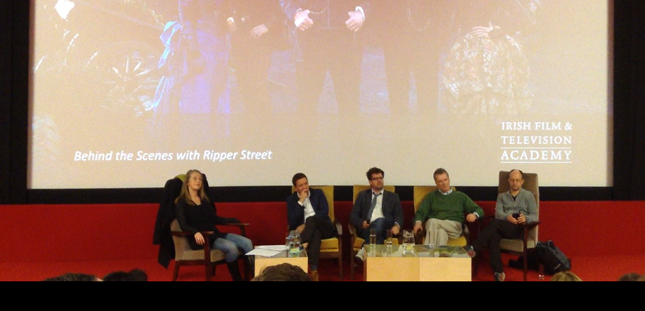'Ripper Street' - Panel Discussion Event

IFTA Ripper Street Event Highlights Irish Creative Talent Across Drama Production
The Irish Film & Television Academy hosted a Behind-the-Scenes Panel Event on Award-winning Period Drama Ripper Street, featuring series creator Richard Warlow, producers Stephen Smallwood, Will Gould (Tiger Aspect Productions) and Ed Guiney (Element Pictures). The 90 minute event was hosted by BAFTA-winning director Neasa Hardiman & attended by IFTA Members, Cast & Crew from the series & invited industry figures. The panel discussion, highlighting the series which receives viewership of almost 7 million each week on BBC and which airs internationally on BBC America, placed a special focus on the Irish creative talent who are integral to the production, which is filmed exclusively in Dublin.
The panel was heightened with contributions from the Irish Heads of Department including editor Una Ní Dhonghaile, production designer Mark Geraghty, locations manager Edmund Sampson and VFX designer Ed Bruce from post-production house ScreenScene all discussing the successes of the series, which was an IFTA winner in 2013 and was also nominated for five BAFTA TV Awards in its first season. Irish Cinematographer PJ Dillon has also been nominated for a British Society of Cinematographers Award for his work on the series.
The panel participants gave particular praise to the Irish crews involved with the show, with Stephen Smallwood calling them “second to none” and commenting upon the ease in which the production was set up in Ireland & how the local industry has benefited the series. Creator Richard Warlow spoke at length, both about the genesis of the series & its distinctive dark tone, explaining that he wished to create “a different kind of period show, one that might use all the skills that we have in these islands for creating period worlds but for another purpose, to make a detective show”. Warlow also referenced the influence of such shows as Deadwood & Hill Street Blues in the creation of Ripper Street and the strong central relationships of the main detective characters.
The participants made special reference to the various heads of department on the Dublin-set which filmed the series in early 2013 for “their sheer dedication and professionalism” throughout the series.
 |
“The crews here are second to none” |
 |
“The only reason the series looks as good as it does isn’t because of budgets, it’s because of the people who work on it so we’re grateful to have lucked out with it” |
 |
“The Irish crew is absolutely front & centre & that is something we can all be really proud of” |
KEY MOMENTS FROM THE PANEL DISCUSSION

In response to Neasa Hardiman’s question on the process of how the UK team initially chose Ireland as a production base...
Stephen Smallwood: “I’m very familiar with the talents of the Irish crew. But after looking a little at places I knew just wouldn’t work such as Hungary or Prague I got hold of the redoubtable location manager Edmund Sampson & asked him to line up a whole bunch of redundant barracks & other suitable locations for us to look at, and ended up at Clancy. The combination of 19th century buildings, office buildings where you could place the production base, parking space for 440 trucks & the sort of outside L-shape of the street where you could also house the interiors of the street relatively cheaply in the existing buildings was where I made my decision with a fairly emphatic confidence based upon really no knowledge whatsoever. Luckily it was backed up by production designer Mark Geraghty who when he came to see the place and who when I asked had I made a bad decision, pretended I hadn’t. He built a fantastic standing set for the street. It is another character on the show and that is entirely down to Mark who has created this amazing set. People say “Was that always here?” and they look at the street with cobbles which is brand new poured concrete but looks like it’s been there forever. It’s down to very skilled design & execution from very good construction crews. Undoubtedly the Irish tax deal was very significant, the crews here are second to none & in addition we also had an investment from the Irish Film Board on the first series which was very enticing.
Ed Guiney: The great thing about Stephen Smallwood is that his default is to look locally in the first instance and that isn’t always the case, sometimes productions don’t want to look at what is already here. We are very tangentially involved with the show, and one of the things that is wonderful about it is that it’s such a wonderful show and it looks amazing but the contribution of the Irish crew is absolutely front & centre & that is something we can all be really proud of & that’s a nice thing to be part of.
Neasa explored how the decision to film in Ireland has been for producers Tiger Aspect...
Will Gould: “From our point of view, Stephen & Mark’s decision to look at that half a street & those buildings & say this could be Ripper Street, it was quite daunting to see if it would really work & it absolutely did. But it was such a key decision and something that every time I watch the show I’m thankful they made that choice. I have to say the crew has been absolutely fantastic, across the board and have been so brilliant. It’s always been a pleasure to come out, some sets can be a bit of chore to visit but this one is always so pleasurable & also because the work is so fantastic. The only reason it looks as good as it does isn’t because of the budgets, it’s because of the people who work on it so we’re so grateful to have lucked out with it.
The unique fast-pace of the series was discussed with Neasa raising the skill of editing...
Una Ní Dhonghaile: “The pace came from Richard’s writing I would say, and trying to keep the audience gripped with the story that was set in Victorian times. But in the editing room, our challenge wasn’t really to keep it visceral but to focus on the characters and the human stories so that the audience actually cared about these characters to a certain degree.”
Neasa observed how the language of the series was a key element & discussed the process of its creation with writer Richard Warlow....
Richard Warlow: “I read a lot of Victorian newspapers, which is probably not as ornate as the language which we use but it was certainly getting there. It was a decision I took at the beginning and being set in a period where the language was so extraordinary and the pronunciation was so correct so it seemed like quite an opportunity and everyone seemed to like it. It’s become a real signature of ours.”
The use of real locations around Dublin city in the filming of the series was also discussed...
Edmund Sampson: “I have a natural curiosity of what’s behind doors anyway, so when we started prep on Season 1 I scouted it & showed them & said “I think we should keep this in the library” because at the very beginning when you start the show you have the initial scripts but then what I tried to do is build up a library because the shooting of the series is so quick, you’re talking about filming a one-hour show every two weeks. That’s one of the gifts of Clancy Barracks, it allows you that base for people to work & create those sets and then we go out for about a 10-day period in that month and during that time other sets are dressed & redressed by the crew under Marks vision recreating new worlds within that space while at the same time we incorporate those locations which give an extra sense of breadth & dimension like The Natural History Museum, which adds to the show.”
The panel discussion also placed a focus on the importance of production design in the series with insightful insight from Mark Geraghty....
Mark Geraghty: “It’s an absolute collaboration, it’s all to do with what one can afford, about texture, lighting, the discipline of directors to try & achieve the scale of colour & people. In realistic terms that set isn’t that big but it’s all about how you shoot it is clever and I think that’s how we achieve Ripper Street. We work it out, we storyboard it, we pick the best angles and then we’ve got Ed Bruce to thank for the absolutely seamless CGI which extended the scale. I think your ambition must be big and especially with myself and the director.”




logomenu.png)